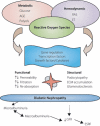Pathogenesis of diabetic nephropathy
- PMID: 24843491
- PMCID: PMC4014960
- DOI: 10.1111/j.2040-1124.2011.00131.x
Pathogenesis of diabetic nephropathy
Abstract
As the increasing prevalence of diabetes reaches epidemic proportions worldwide, diabetic nephropathy and associated end-stage renal failure will be an unavoidable major health burden to not only individuals with diabetes and their families, but also to the health systems both in developed and developing countries. Over the past decade, a large body of research has focused on diabetic nephropathy ranging from studies in molecular signaling, hemodynamic regulation and pharmaceutical intervention to clinical outcomes. It is likely that the pathophysiology of diabetic nephropathy involves a multifactorial interaction between metabolic and hemodynamic factors. Metabolic factors involve glucose-dependent pathways, such as advanced glycation end-products and their receptors. Hemodynamic factors include various vasoactive hormones, such as components of the renin-angiotensin system. It is likely that these metabolic and hemodynamic factors interact through shared molecular and signaling pathways, such as nuclear factor kappa-light-chain-enhancer of activated B cells and protein kinase C with associated reactive oxygen species generation. It is likely that these contributing factors cause pathological damage not only to the glomerulus, in particular podocytes, but also to the tubulointerstitium. Specific inhibitors of the various pathways are now available and these emerging pharmaceutical interventions might have potential implications for the prevention and treatment of diabetic nephropathy. The mainstay of therapy remains the achievement of optimal glycemic and blood pressure control in order to slow the progression of diabetic nephropathy. Agents that interrupt the renin-angiotensin system have been shown to be particularly useful as renoprotective agents in both hypertensive and normotensive type 1 and type 2 diabetic subjects. (J Diabetes Invest, doi: 10.1111/j.2040-1124.2011.00131.x, 2011).
Keywords: Angiotensin converting enzyme 2; Cell division autoantigen 1; Reactive oxygen species.
Figures

References
-
- Cooper ME. Pathogenesis, prevention, and treatment of diabetic nephropathy. Lancet 1998; 352: 213–219 - PubMed
-
- Cooper ME. Interaction of metabolic and haemodynamic factors in mediating experimental diabetic nephropathy. Diabetologia 2001; 44: 1957–1972 - PubMed
-
- Tikellis C, Bernardi S, Burns WC. Angiotensin‐converting enzyme 2 is a key modulator of the renin‐angiotensin system in cardiovascular and renal disease. Curr Opin Nephrol Hypertens 2010; 20: 62–68 - PubMed
Publication types
LinkOut - more resources
Full Text Sources
Other Literature Sources
Medical
Research Materials
Miscellaneous

